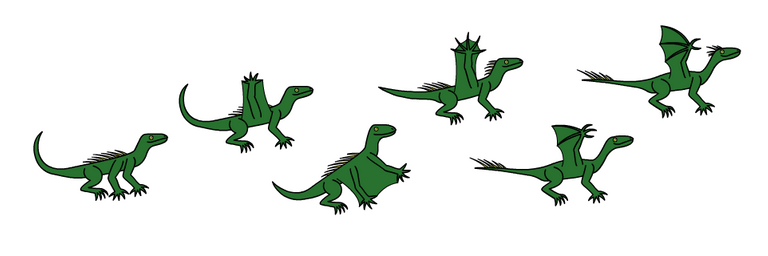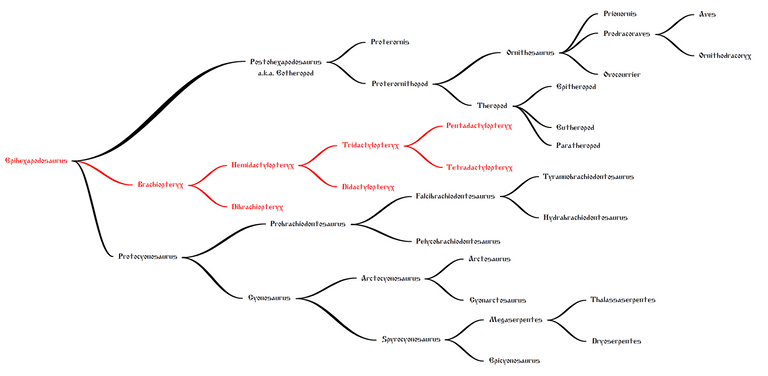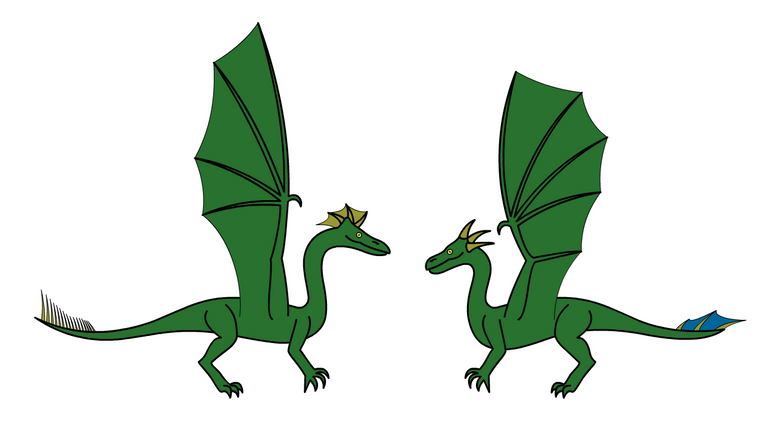In yesterday's post, I showed off some wyrms and far more bizarre creatures from my fictional world. Today, I'll be showing off some more of the "classic" or "European" dragons. They start out with lizard-like arboreal dinosaurs:
Notice that the two drawings on the right look like miniature dragons. However, they're still just tiny hexapod dinosaurs, much like most of the creatures I showed off yesterday. Going back to the tree:
This time, we're looking at the middle branch:
And these are the names:
All this began with six-legged flying squirrel lizards, some of which looked like Brachiopteryx as I have drawn it, while others had a membrane connecting all three legs on both sides. Dibrachiopteryx, on the other hand, specialised the front two pairs of legs, making them thinner and lighter, with a membrane between those alone. This was a response to competition with wyverns, and the tiny dinosaur was still arboreal, but exclusively bipedal. Hemidactylopteryx went in the opposite direction, specialising only its middle pair of legs, elongating the fingers but keeping strong arms. Further elongation of the fingers resulted in Didactylopteryx and Tridactylopteryx, both of which are starting to look like dragons. How far do we have to go before we can say "all right, that's a dragon now?" Well, if you haven't read "Dracologeny" on my WordPress blog yet, prepare for the weirdest plot twist.
Below are the two top specimens from the cladogram, both of which descend from Tridactylopteryx:
The one on the left is Tetradactylopteryx, which is almost a dragon, and the only thing that separates it from true dragons is a technicality. The one on the right is Pentadactylopteryx, the first flying dragon to evolve on Varanganska. Notice the barb on the elbow, supporting a wing that is shorter, but with the same area as its cousin. For this reason, it could also be called "Pseudodactlyopteryx," but that name could apply to an awful lot of things. However, this elbow barb is not what makes it a dragon - what makes it a dragon is that it doesn't lay eggs. That's right, the definition of a dragon in Varanganskan phylogenetics is "an endothermic, viviparous dinosaur." Epihexapodosaurus was warm-blooded, so all of its descendants were as well.
Tetradactylopteryx, strangely enough, was far larger than any true dragon, but proportioned very differently, and not adapted for powered flight the way that true flying dragons are. Pentadactylopteryx on the other hand, has a keeled sternum, like birds, and more suited to powered flight than gliding. Subsequent adaptations allow its descendants to fly extremely well, such as the shape of the wing:
Pandactylopteryx began adapting the thumb into a leading-edge flap, and that transition is complete in Acanthopteryx. I haven't yet decided which of these survives long enough to witness the events of The Nine Empires, but it may end up being all three. There may or may not be reasons for dragons of different sizes to adopt different wing shapes, but that will be dictated entirely by the environment in which they live, and I haven't figured that part out yet. Otherwise, there isn't any noticeable difference between the three:
In the future, I'll elaborate on the aeronautics of flying dragons and birds, and parallels that exist in the design of aeroplanes. However, I'm going to finish this origins series first, with feathered dragons discussed next, bizarre birds after that, and other strange creatures of my fictional world as I come up with them.






